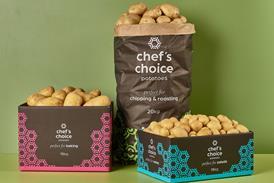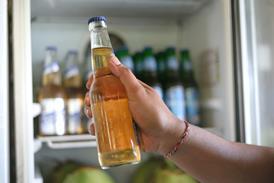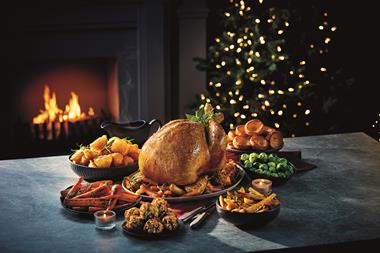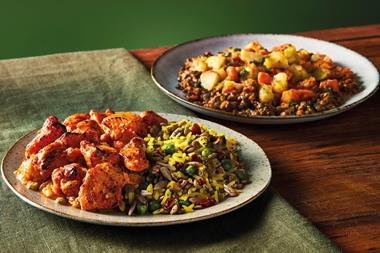Exclusive research for The Grocer shows how retailers are letting opportunities to convert top-up shoppers to primary shoppers pass them by. Siân Harrington reports
It is no surprise to find that the bulk of consumers who do their top-up shop at a Tesco superstore are also doing their primary shop at the store. But why are more Sainsbury top-up customers doing their main shop in Tesco rather than in Sainsbury stores?
Exclusive research for The Grocer among 1,721 main household shoppers reveals that a significant number of consumers are not loyal to their main supermarket when it comes to top-up shopping.
The survey, carried out by HI Europe, shows that nearly a quarter (22%) of those topping-up in a Tesco or Tesco Extra do their bulk shop in Asda while 19% use Sainsbury for a major shop. About 23% of Asda’s top-up customers are Tesco primary shoppers while 31% of Sainsbury’s top-up shoppers come from Tesco. An insignificant amount of Marks and Spencer top-up customers do their primary shop at the fascia, most preferring to bulk shop in Tesco, Asda and Sainsbury (see charts overleaf).
For the multiples, the results present both a threat and an opportunity. On the one hand, each retailer has new customers over the threshold who have the potential to be converted to primary shoppers.
Retailers can showcase their offers and tempt the top-uppers to return and spend more.
And, according to research from ID Magasin, these top-up shoppers linger longest in the multiples, giving the stores more time than any other format to promote their offering. An average of 21.15 minutes is spent by a top-up shopper in a multiple while top-up shoppers in the multiples’ convenience store fascias spend just 3.48 minutes and those in traditional convenience stores spend 2.20 minutes and in forecourts just 1.36 minutes.
On the other hand, there are clearly reasons why these shoppers don’t stay with the one retailer and their three main reasons for choosing where to do a main top-up shop give some clues.
Those favouring a Tesco supermarket for top-up look for ease of parking, proximity to home and value for money while those who choose Asda for a top-up want good value for money first, followed by good range and ease of parking.
Sainsbury is chosen for good range first and foremost, as is Marks and Spencer.
It appears then that many shoppers are driven by price when doing their bulk shop but are looking for something different for a top-up shop.
The research helps pure convenience players to gain an insight into their shoppers’ views on price and range. Nearly a third of the Co-operative Group’s top-up customers bulk shop in Tesco, 26% in Asda and 15% in Sainsbury - suggesting they are generally price-sensitive.
Spar pulls evenly from Tesco and Asda, at 35% and 34% respectively, with just 6% of top-up shoppers coming from Sainsbury.
A quarter of Marks and Spencer’s Simply Food’s top-up customers are Tesco primaries and a quarter do their main shop in Sainsbury. Proximity to home, speed of getting in and out and friendly service are the main reasons for using a local independent. Shoppers at Marks and Spencer and the Co-operative Group also look for friendly service while Somerfield’s top-up customers are the only ones to mention promotions.
More than four in 10 visits to traditional c-stores are not planned, says ID Magasin, although 57% of shoppers are looking for specific products when in such a store. Eight in 10 multiple top-up shoppers plan their visits but they are the least likely shoppers to be looking for specific items (just 5%).
In contrast, while 79% of multiple c-store shoppers plan their trip, nearly a third are looking for a specific product and, of the 82% who plan to visit a forecourt, 60% intend to go to the shop. A quarter of those want to buy something to eat, 14% intend to buy a newspaper and 11% need something to drink.
When it comes to the multiples’ convenience offers, most pull from their primary shoppers. The Sainsbury’s Local fascia has particular resonance among its supermarket shoppers, with half of its top-up customers doing their primary shop in a Sainsbury supermarket.
And their moves into the convenience market are helping to raise the perception of small stores. Over a quarter of Tesco Metro/Express shoppers believe small stores are better value than a year ago and 61% say standards are better.
Sainsbury’s Local shoppers are even more impressed by the value - 35% believe small stores are better value than a year ago and 57% say standards are better. But the message does not seem to be getting through to these retailers’ primary shoppers.
Only 18% of both Tesco and Sainsbury main shoppers believe small store value is better and half that standards are better.
It appears, however, that Marks and Spencer has the biggest job to do in terms of pricing - 17% of main shoppers believe that small stores are better value, but this falls to 15% when they are Simply Food shoppers.
It is no surprise to find that the bulk of consumers who do their top-up shop at a Tesco superstore are also doing their primary shop at the store. But why are more Sainsbury top-up customers doing their main shop in Tesco rather than in Sainsbury stores?
Exclusive research for The Grocer among 1,721 main household shoppers reveals that a significant number of consumers are not loyal to their main supermarket when it comes to top-up shopping.
The survey, carried out by HI Europe, shows that nearly a quarter (22%) of those topping-up in a Tesco or Tesco Extra do their bulk shop in Asda while 19% use Sainsbury for a major shop. About 23% of Asda’s top-up customers are Tesco primary shoppers while 31% of Sainsbury’s top-up shoppers come from Tesco. An insignificant amount of Marks and Spencer top-up customers do their primary shop at the fascia, most preferring to bulk shop in Tesco, Asda and Sainsbury (see charts overleaf).
For the multiples, the results present both a threat and an opportunity. On the one hand, each retailer has new customers over the threshold who have the potential to be converted to primary shoppers.
Retailers can showcase their offers and tempt the top-uppers to return and spend more.
And, according to research from ID Magasin, these top-up shoppers linger longest in the multiples, giving the stores more time than any other format to promote their offering. An average of 21.15 minutes is spent by a top-up shopper in a multiple while top-up shoppers in the multiples’ convenience store fascias spend just 3.48 minutes and those in traditional convenience stores spend 2.20 minutes and in forecourts just 1.36 minutes.
On the other hand, there are clearly reasons why these shoppers don’t stay with the one retailer and their three main reasons for choosing where to do a main top-up shop give some clues.
Those favouring a Tesco supermarket for top-up look for ease of parking, proximity to home and value for money while those who choose Asda for a top-up want good value for money first, followed by good range and ease of parking.
Sainsbury is chosen for good range first and foremost, as is Marks and Spencer.
It appears then that many shoppers are driven by price when doing their bulk shop but are looking for something different for a top-up shop.
The research helps pure convenience players to gain an insight into their shoppers’ views on price and range. Nearly a third of the Co-operative Group’s top-up customers bulk shop in Tesco, 26% in Asda and 15% in Sainsbury - suggesting they are generally price-sensitive.
Spar pulls evenly from Tesco and Asda, at 35% and 34% respectively, with just 6% of top-up shoppers coming from Sainsbury.
A quarter of Marks and Spencer’s Simply Food’s top-up customers are Tesco primaries and a quarter do their main shop in Sainsbury. Proximity to home, speed of getting in and out and friendly service are the main reasons for using a local independent. Shoppers at Marks and Spencer and the Co-operative Group also look for friendly service while Somerfield’s top-up customers are the only ones to mention promotions.
More than four in 10 visits to traditional c-stores are not planned, says ID Magasin, although 57% of shoppers are looking for specific products when in such a store. Eight in 10 multiple top-up shoppers plan their visits but they are the least likely shoppers to be looking for specific items (just 5%).
In contrast, while 79% of multiple c-store shoppers plan their trip, nearly a third are looking for a specific product and, of the 82% who plan to visit a forecourt, 60% intend to go to the shop. A quarter of those want to buy something to eat, 14% intend to buy a newspaper and 11% need something to drink.
When it comes to the multiples’ convenience offers, most pull from their primary shoppers. The Sainsbury’s Local fascia has particular resonance among its supermarket shoppers, with half of its top-up customers doing their primary shop in a Sainsbury supermarket.
And their moves into the convenience market are helping to raise the perception of small stores. Over a quarter of Tesco Metro/Express shoppers believe small stores are better value than a year ago and 61% say standards are better.
Sainsbury’s Local shoppers are even more impressed by the value - 35% believe small stores are better value than a year ago and 57% say standards are better. But the message does not seem to be getting through to these retailers’ primary shoppers.
Only 18% of both Tesco and Sainsbury main shoppers believe small store value is better and half that standards are better.
It appears, however, that Marks and Spencer has the biggest job to do in terms of pricing - 17% of main shoppers believe that small stores are better value, but this falls to 15% when they are Simply Food shoppers.















No comments yet